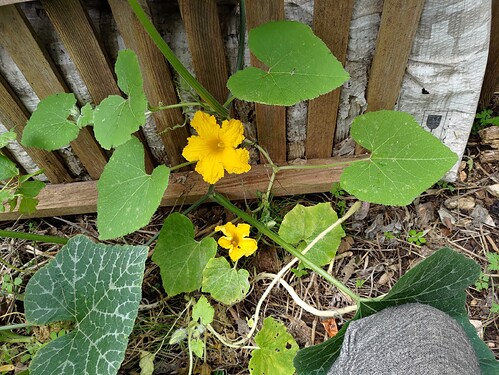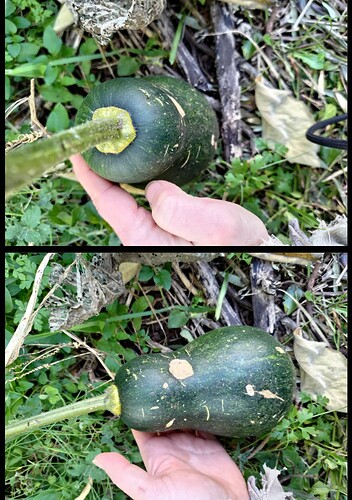A bit of update on gathered seeds from the zucchini and cucumber fruits from the above post.
Zucchini had some 10 good and healthy looking seeds - this will be a nucleus for starting a landrace this year :-).
On the other hand, late cucumber wasn’t a success - it started rotting at the top so I had to harvest it and open. There were fine number of seeds inside with gelatinous coat and looking nice (to my untrained eye re. mature cucumber seeds), but they all dried out completely and it turned out all were empty, or maybe not mature enough, so everything dried out. I did collect small amount of seeds of cucumber from the first round so that will be a start.
On to squashes/pumpkins (I never know when to call them squash and when pumpkin  ).
).
I’ve sown them very late for my area, around late June/early July, in two small patches. One patch didn’t make it past summer, but the other one did, and started to grow well with first rains in September. I need some help with figuring out what squashes I’ve got growing because, off course, I didn’t write it down what’s what when sowing this particular patch and would like to know which seeds I tried and which didn’t. Seeds came from various serendipity box packages 

Note - this will be a lengthy/detailed post for what is actually a small harvest, mostly because I need your help determining what I have (for my own record too  ).
).
First, let’s see what it looked like growing and what I’ve got. List of possible populations sowed is at the end of the post.
I’ve sown them next to the compost pile in a small elongated patch, from 3 different baggies/populations, this is from early August (you can also notice few runner bean plants struggling, didn’t make it)
1. package (baggie/population)
One plant on the right was distinct from other plants in it’s form (flowers, leaves), had just male flowers and was slow growing (more shaded than others so that could also account for slow speed). It is the only plant that sprouted and survived from that package, but unfortunately there were no female flowers and then it died. This photo is from late September/mid October
2. and 3. package (baggie/population)
With first rains and lower temps all others started to grow like crazy in all directions, with both female and male flowers. All of them looked really similar re flowers and leaves, but I’m almost 100% certain those came from two different packages. Since they were all intertwined it was a bit hard to say what’s what.
How it looked in October:
In all, I counted 6 plants growing, some more vigorous, some slower. At the end 3 plants gave me maturing fruits, each plant with different type of fruit. Two plants had roundish fruit with different type/look of fruits and there was one plant with fruit that look more like hourglass (similar to butternuts).
Other three plants had female flowers which were roundish, but didn’t get maturing fruits from them. Since it was already end of October, early November when they started producing female flowers, it’s no wonder :-).
And some ants in action 
In the end, I had 4 fruits and the plan was to leave them maturing in the garden as long as possible. Since we rarely get frosts (and none this winter so far) that was not the problem, but November and December here means more rain and cloudy days (our main rainy season), and plants lost all their leaves and I’ve harvested them all by the end of December.
Plant with the ‘hourglass’ fruit
Just one small fruit, dark green, but this plant lost its leaves earlier than others so I don’t know if that is it’s final size or not. I did leave this one on the plant until central vine dried out too.
Pollinated cca 12/13.10. Harvested 11.12.
Around 8-9 days after pollination
Some photos of leaves (with the same fruit but older), I don’t have any flower photos, but they looked like the other ones (photos further below).
A week before harvest
Harvested (in comparison to the biggest one from second plant)
Since it started rotting from the top pretty soon I’ve opened it up on 27.12. I hoped for some viable seeds, but it seems like this was a border case. Some seeds looked empty, some full, but one month later when properly dried, all seeds looked empty. I opened few and there is a tiny seed in some, more are empty. I decided to keep it all and in springtime I’ll just put everything in some corner of the garden in one spot. Maybe they will surprise me, if not it doesn’t matter :-).
In raw state it had blandish taste, kind of like it wasn’t mature enough (no surprise there…), we mixed it in some dishes so it was ok.
Plant with round fruit 1
Biggest fruit, just one roundish and dark green. Pollinated cca 20.-25.9. Harvested 11.12.
This plant was the first one to grow large and start with female flowers, it had nice growth. Fruit was from one of the earliest fem. flowers, there were more later but no pollination.
Based on the position of sprouting and roots it could come from the same population as the ‘hourglass’ one.
Some flowers
Just pollinated
Mid October and end of the same month:
Since it was harvested some 2,5 months after pollination, I’m counting on this one to have mature viable seeds. It is the same one in the ‘harvested photo’ with butternut/hourglass fruit above.
Some 1,5 months in storage, freshly accompanied by squashes from the third plant
It is still in storage and after the ground spot darkened from yellow to orange, the rest of it started to show some orange/tan pigment and spots too. I’ll probably open it by the end of this month.
This is from the other day, so some 3 months after harvest, photographed from 4 sides:
Plant with round fruit 2
This was one plant with two fruits. Roundish but slightly flattened, dark green with light stripes/spots. Pollinated 19. i 20.10. Harvested 28.12.
Started with female flowers latest (from three plants with mature fruits) but it was very vigorous. Judging by it’s position it could be from another package then two previous ones, but I can’t be sure.
One ‘branch’ of the plant
Flowers
Few days after pollination
Growing
Harvested - more than 2 months after pollination so I’m hoping those two will have viable seeds too. I have to take in account they were maturing during November and December when there’s less daylight hours, I’m thinking seed development is slower and ~55 days isn’t enough in those conditions.
1,5 months in storage
And the question is…
I’ve sown seeds from 3 different baggies/populations out of 9 possibilities, list bellow. Since seeds came from European serendipity box, @Tanjaeskildsen @ThomasPicard @Hugo @malterod @JesseI - this could be some of yours and you’ve definitely have more experience growing cucurbitae than me. I have some ideas (like moschata  ), but have zero experience growing them and the seeds came from diverse packages so…
), but have zero experience growing them and the seeds came from diverse packages so…
I’d like to figure out what two seeds bags/populations I used for the squashes I harvested, but also what was that one plant distinct from others that didn’t make it. What do you all think??
List of possibles (I’m pretty sure I didn’t use last two)
- C.moschata grex: mostly green fleshed ayote crossed with seminole pumpkins, Lofthouse moschata & musk de Provence, Tanja - I’m pretty sure I’ve used this one (grown in my climate zone)
- C.moschata x argyrosperma mix (likely 75%,25%), 2023, Jesse
- C.moschata everyone mix
- winter pepo squashes acorn x pumpkins, F2 grex, 2023, Thomas
- C.mixta green/white, mother grow out, 2023 Hugo
- Tetsukabuto x maxima F1, untested, 2023, CF
- C.maxima small, grex 2022, Thomas
- C.maxima mix: everyone together + big maxima grex 2022 Thomas + sweet fall x pink jumbo x pearl pink 2022-23
- rugosa Friulana x squash, 2023
























































